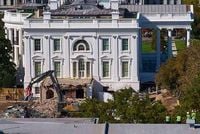When bulldozers began tearing into the East Wing of the White House in October 2025, the scene was nothing short of historic—and, for many, deeply controversial. The demolition, which left the two-story structure in ruins, marked the first time in over a century that such a significant portion of the Executive Mansion was removed. The reason? President Donald Trump’s ambitious plan to construct a 90,000-square-foot ballroom, a project whose scale, funding, and symbolism have sparked fierce debate across the political spectrum.
According to ABC News and The Associated Press, the cost of the new ballroom has ballooned from an initial $200 million estimate in July to nearly $300 million by late October, with President Trump himself updating the price tag and suggesting that the fundraising total could reach $350 million. The president has repeatedly insisted that the project will be paid for entirely by private donors—specifically, wealthy individuals from the tech and defense industries—ensuring, as he put it, “zero cost to the American taxpayer.” In a Truth Social post, Trump declared, “I am honored to be the first President to finally get this much-needed project underway—with zero cost to the American Taxpayer! The White House Ballroom is being privately funded by many generous Patriots, Great American Companies, and, yours truly. This Ballroom will be happily used for Generations to come!”
The ballroom, when completed, will be nearly twice the size of the White House itself, which stands at 55,000 square feet. Designed to accommodate up to 650 seated guests, the venue is intended for grand parties, state visits, and other high-profile events. Trump has argued that every president for the past 150 years has dreamed of such a space, saying the East Wing had been “very, very much changed from what it was originally” and was “ready to be replaced.”
Yet the project has not been universally welcomed. The demolition of the East Wing, built in 1902 and expanded in 1942, signaled the loss of a space that had long served as the base for the First Lady, the social and military offices, and the visitors’ center. It was also where the public entered for tours, state dinners, and holiday receptions. As AP reported, these operations have been temporarily relocated elsewhere on the White House campus, and public tours were halted in late summer in preparation for construction.
Preservationists and lawmakers quickly voiced their concerns. The National Trust for Historic Preservation, in a letter to the National Capital Planning Commission, the National Park Service, and the Commission of Fine Arts, warned that the scale of the new ballroom “may permanently disrupt the carefully balanced classical design of the White House.” Carol Quillen, president and CEO of the Trust, stated, “We acknowledge the utility of a larger meeting space at the White House, but we are deeply concerned that the massing and height of the proposed new construction will overwhelm the White House itself—it is 55,000 square feet—and may also permanently disrupt the carefully balanced classical design of the White House with its two smaller, and lower, East and West Wings.”
Senate Minority Leader Chuck Schumer was even more blunt, calling the project a “vanity project.” Massachusetts Senator Elizabeth Warren took to social media to criticize the cost, writing, “Oh you’re trying to say the cost of living is skyrocketing? Donald Trump can’t hear you over the sound of bulldozers demolishing a wing of the White House to build a new grand ballroom.” California Governor Gavin Newsom’s press office, not to be outdone, posted a tongue-in-cheek message suggesting the ballroom be renamed “The Epstein Files Storage Facility.”
Trump’s supporters, however, see the project as a fitting legacy. Some tourists, like Erich Habelt of California, expressed little concern: “It’s his house. He can do with it, you know, he’s spending his money and not my taxpayer money. It’s OK with me. And as with any old house, things need to be renovated.” Of course, as AP pointed out, the White House is government property, not Trump’s personal residence.
The process by which the demolition began has also raised eyebrows. The White House allowed demolition to proceed without advance public warning or approval from the usual government agencies that oversee construction on federal buildings. White House press secretary Karoline Leavitt explained, “They have ruled consistently, their general counsel has said, when it comes to Phase One of this project, the tearing down of the current East Wing structure, a submission is not required legally for that. Only for vertical construction will a submission be required. That’s a legal opinion from them, and we are following that legal opinion.” Preservationists, however, argue that the review process, including public comment, is crucial for transparency and engagement—a tradition dating back to the original White House design competition in 1792.
Adding to the drama is the ongoing speculation about the ballroom’s eventual name. Early reports, including from ABC News, suggested the project might be dubbed the “Donald J. Trump Ballroom.” Yet Trump himself has dismissed these rumors as “fake news,” telling reporters he had “no plans” to name the extension after himself and instead floated the idea of calling it the “presidential ballroom or something like that.” White House spokesperson Davis Ingle affirmed, “Any announcement made on the name of the ballroom will come directly from President Trump himself, and not through anonymous and unnamed sources.”
The project’s timeline is another point of contention. Official press releases suggest the ballroom will be completed “long before the end of President Trump’s term,” which expires in January 2029. But The New York Times described this as “optimistic,” noting that construction on this scale often runs into delays. The White House has promised that, alongside the ballroom, a more modern East Wing will be rebuilt, though details remain scarce.
Meanwhile, the debate over the ballroom’s necessity, cost, and impact on the White House’s historic character continues to rage. For some, the project is a long-overdue modernization; for others, it’s an unnecessary extravagance that erases a vital piece of American history. As the dust settles—literally and figuratively—one thing is clear: the new ballroom will be a defining symbol of the Trump presidency, for better or worse, and its legacy will be debated for generations to come.

